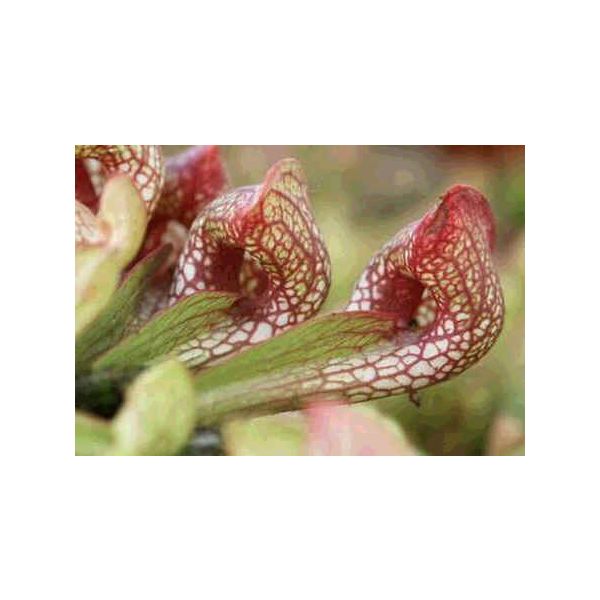Sarracenia Psittacina Seeds (Parrot Pitcher Plant Seeds)
Sarracenia Psittacina Seeds (Parrot Pitcher Plant Seeds)
This is an unusual plant that looks very different from any of the other Sarracenia. The pitchers have what almost looks like a beak above the small mouth of the pitcher, hence the common name Parrot Pitcher Plant.

Delivery
All orders shipped with UPS Express.
Always free shipping for orders over US $250.
All orders are shipped with a UPS tracking number.
Returns
Items returned within 14 days of their original shipment date in same as new condition will be eligible for a full refund or store credit.
Refunds will be charged back to the original form of payment used for purchase.
Customer is responsible for shipping charges when making returns and shipping/handling fees of original purchase is non-refundable.
All sale items are final purchases.
Help
Give us a shout if you have any other questions and/or concerns.
Email: contact@domain.com
Phone: +1 (23) 456 789
Availability: Out of stock
SKU
Sarracenia Psittacina
You will find Sarracenia psittacina in Southern parts of Alabama, Mississippi and Georgia, as well as the Northern parts of Florida. The pitchers reach a length of 15cm.
This is an unusual plant that looks very different from any of the other Sarracenia. The pitchers have what almost looks like a beak above the small mouth of the pitcher, hence the common name Parrot Pitcher Plant. The pitchers lie about horizontal to the ground and by means of downward pointing hairs guide prey to the digestion zone. The plant uses windows to deceive the prey to the trapping zone.
The flowers are deep red. The blooms first appear in mid Spring and continue into early Fall. The scape curves at the end so that the flower points down. Clip off old leaves to make way for flower buds and new leaf growth.
Hardiness zone 8 (-10øC/15øF) in Winter. They can grow well in pure sphagnum moss, live, long fibered or shredded, as well as the standard peat moss/sand which can be anything from 30% to 100% peat moss. There's no need to fertilize, as the plant relies on insects for food. The humidity should be between 60-80%.
Requires consistently moist soil; do not let dry out between waterings. This species grows in areas that are often very boggy and can stand long periods of flooding. In fact these plants may even be more accomplished at catching aquatic prey than things such as ants and flies. Water must be distilled or rain water because they do not tolerate city or hard water. It is a good idea to place a pie pan or large saucer, with about an inch of water in it, under the pot. Elevate the pot by placing pebbles under it so that the base of the pot is barely in contact with the water, not submerged; the growing medium must stay moist, but never soggy. This will keep the humidity around the plant higher and it will ensure that the plant has a constant source of moisture.
They should be grown in bright light, but with protection from full midday sun. In cloudy coastal areas, artificial light is a must. They need a dormant period of about 3 months in the Winter. The typical heated home is too warm in the Winter. The entire planter may be moved to an area where the temperature will remain at 2-5øC / 35-40øF. Unusually, this plant does best if kept flooded over the Winter months, as opposed to all the other Sarracenia which should be kept damp. If left outside during Winter, protect them from dry freezing wind during deep freezes by covering the plant with black plastic. Uncover the plant when the deep freeze and dry freezing wind is over. Otherwise, place it in a refrigerator for 3-5 months in a ziplock bag.
| Common name | Parrot Pitcher Plant |
|---|---|
| Species | Sarracenia psittacina |
| Germination | The seeds require 6 weeks cold stratification before sowing, directly on the surface of your moist but not soaked soil mix. Once it's time to take the seeds out of cold stratification, cover the top of the pot with clear plastic so the humidity will remain high, place them in an area with real nice strong light and keep the temperature around 21øC/70øF, 27øC/80øF. When you see some tiny plants starting to sprout, slowly open the top of the pot, a little each day, so that the new seedlings don't go into shock from the humidity being lowered too quickly. After cold stratification, germination usually occurs in 1 to 3 months, but it can take longer, depending on their degree of unbroken dormancy, don't give up. |
| Scarification / Stratification | It creates a cold and moist environment for the seeds. This will break their dormancy. Place the seeds on top of a prepared soil mix. The pot is then placed into a ziplock bag with approximately an inch of water on the bottom of the bag. Close the bag shut and place it into the salad crisper compartment of your refrigerator. Make sure to check the seeds often. If fungus or mold appears treat it with a fungicide. |
| Price View | Price Range |

